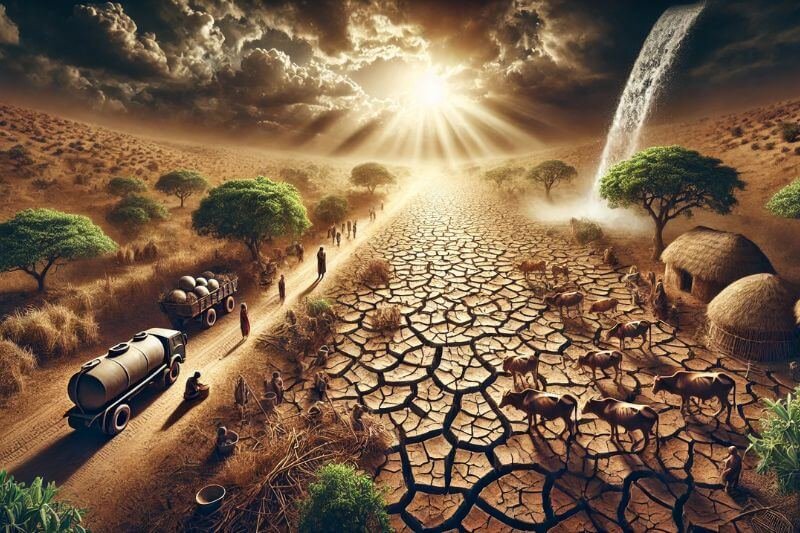The Emerging Crisis of African Droughts
Africa is currently experiencing unprecedented drought conditions, creating severe humanitarian crises and generating significant global repercussions. Countries such as Ethiopia, Somalia, Kenya, Sudan, and Nigeria have reported record-low rainfall and devastating agricultural impacts. With millions facing food shortages and widespread water scarcity, this crisis is swiftly moving from a regional issue into a global concern. This article explores the extensive implications of extreme drought in Africa and outlines critical survival strategies to address the far-reaching impacts of such climate disasters.
Understanding the Scale of Africa’s Extreme Drought
Severity and Geographic Spread
Recent reports from climate scientists and humanitarian agencies indicate that Africa’s drought conditions have reached alarming levels. Particularly hard-hit regions include the Horn of Africa, the Sahel, and southern African nations. In Ethiopia alone, over 7 million people are severely affected, while Somalia and Kenya report similar distressing figures. Reduced rainfall over successive rainy seasons has led to dried-up water sources, destroyed agriculture, and decimated livestock herds.
Causes Behind the Crisis
Climate scientists attribute the current crisis to various factors, including global climate change, deforestation, desertification, and increasingly erratic rainfall patterns linked to phenomena like El Niño and La Niña. Deforestation and unsustainable agriculture practices further exacerbate soil degradation and reduce water retention, amplifying drought severity.
Global Repercussions of Africa’s Drought
Food Supply Chain Disruptions
Africa is a significant contributor to global agriculture, particularly in products like coffee, cocoa, grains, and fruits. The current drought crisis severely impacts crop yields and livestock production, causing shortages and price spikes worldwide. Nations reliant on African exports, including Europe, Asia, and North America, are already experiencing noticeable increases in food prices.
Migration and Humanitarian Crises
Severe drought inevitably triggers mass migration. Millions fleeing drought-affected regions overwhelm neighboring nations and international borders, creating humanitarian crises and geopolitical tensions. European and Middle Eastern nations are particularly vulnerable as migration intensifies, prompting complex security and humanitarian responses.
Economic Instability
African economies heavily reliant on agriculture are significantly destabilized by prolonged drought conditions. Economic instability can quickly spill over into international financial systems, increasing poverty rates, lowering productivity, and causing broader economic downturns regionally and globally.
Survival and Preparedness Implications
Importance of Water Independence
In a world increasingly impacted by droughts, water independence is a survival priority. Communities must prioritize rainwater harvesting, water storage solutions, and water purification technologies. Rainwater harvesting systems and advanced filtration methods allow self-reliance during periods of extreme drought, safeguarding against the collapse of public water infrastructure.
Food Security and Storage Solutions
Food shortages are inevitable during severe droughts. Survival preparedness involves creating extensive emergency food reserves, focusing on non-perishable goods and long-term storage solutions. Building a robust personal or community pantry stocked with grains, legumes, dehydrated vegetables, canned goods, and nutritional supplements significantly improves resilience against prolonged disruptions.
Sustainable Agricultural Practices
The crisis in Africa highlights the urgent need for sustainable agriculture. Permaculture techniques, drought-resistant crops, vertical gardening, and hydroponics enable food production even in adverse climatic conditions. Transitioning to these methods can ensure sustained agricultural output during drought periods, significantly reducing reliance on international food supplies.
International Response and Aid Challenges
The Limitations of Emergency Aid
While international humanitarian aid provides immediate relief, it often remains insufficient and unsustainable in the long term. Aid programs frequently struggle with logistical barriers, corruption, inadequate resources, and the inability to reach remote, severely impacted regions. Recognizing these limitations underscores the importance of local resilience-building efforts.
Long-term Investment in Climate Resilience
True resilience against drought disasters demands proactive, long-term investment strategies. These strategies include constructing sustainable water infrastructure, supporting drought-resistant agriculture, enhancing early-warning systems, and investing in community-based education and training programs focused on survival skills and resource management.
Global Cooperation and Climate Policy
Addressing drought crises on a global scale requires international cooperation. Strengthening global climate agreements, reducing emissions, supporting reforestation efforts, and fostering technology transfer between developed and developing nations are essential actions for mitigating future drought crises.
Practical Survival Tips for Individuals and Communities
Water Conservation Practices
- Install low-flow faucets and water-efficient appliances.
- Recycle greywater for irrigation and sanitation.
- Establish rainwater collection and storage systems.
Emergency Food Management
- Maintain a rotating stockpile of emergency food supplies.
- Prioritize nutritious, calorie-dense foods suitable for long-term storage.
- Learn food preservation methods such as drying, canning, and fermenting.
Communication and Information Networks
- Establish reliable communication channels with local community members.
- Invest in shortwave radios, satellite phones, or emergency alert devices.
- Stay informed through trusted local and international news sources.
Building Community Resilience
- Form or join local resilience networks to share resources, knowledge, and skills.
- Engage in collective training exercises and preparedness drills.
- Foster strong community relationships to facilitate effective cooperation during crises.
Taking Immediate Action for Future Survival
The extreme drought devastating Africa is a wake-up call for survival preparedness worldwide. With global impacts already emerging, understanding and implementing these essential survival and preparedness strategies is critical. Strengthening individual and community resilience, improving water independence, adopting sustainable agriculture practices, and enhancing global cooperation can significantly mitigate the risks and impacts of such climate disasters.
While Africa’s drought crisis poses substantial humanitarian and economic challenges, it also provides an essential learning opportunity. Preparedness efforts initiated today can ensure that individuals, communities, and nations are better equipped to handle severe droughts in the future. Survival preparedness is no longer optional; it is now an urgent global necessity.















